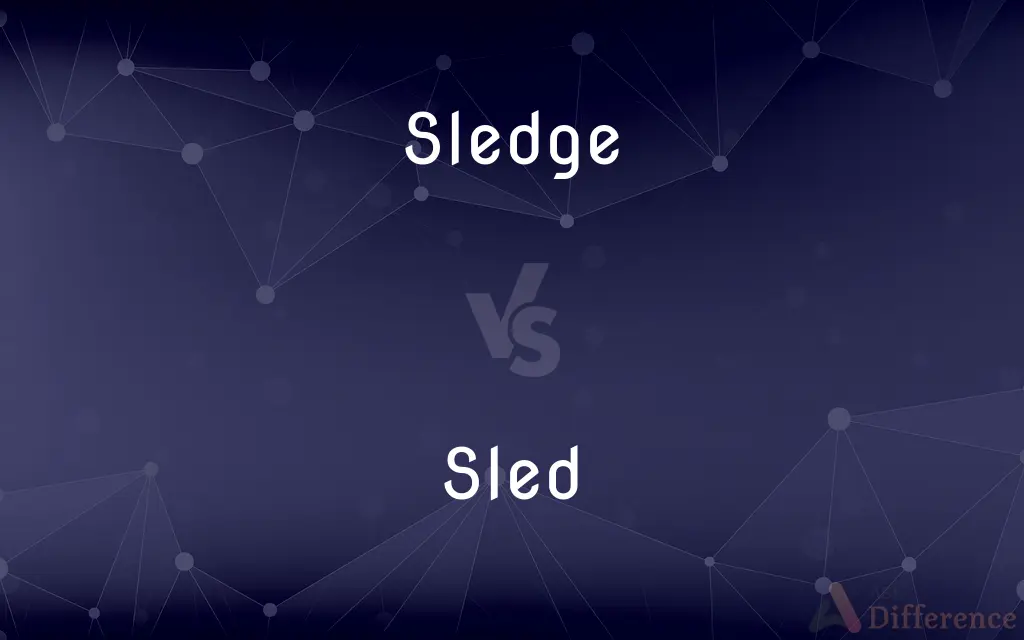Sledge vs. Sled — What's the Difference?
Edited by Tayyaba Rehman — By Maham Liaqat — Updated on March 12, 2024
A sledge is a heavy, often large, vehicle for outdoor use, while a sled is typically lighter and used for recreation or transport over snow.

Difference Between Sledge and Sled
Table of Contents
ADVERTISEMENT
Key Differences
Sledges are designed for heavy-duty tasks such as hauling goods or people across snowy terrains, often pulled by animals or machines. Whereas sleds are generally smaller and lighter, making them ideal for recreational activities like sledding down snowy hills.
Sledges are built to endure rough and uneven surfaces, featuring robust construction and sometimes equipped with runners for stability. On the other hand, sleds may have smooth bottoms or runners and are crafted for speed and maneuverability on snow-covered slopes. In some regions, the terms "sledge" and "sled" are used interchangeably, yet they can signify different types of snow vehicles based on local traditions and usage.
Sledges often have a flat surface or a cargo area for transporting materials or passengers, highlighting their utility in work-related contexts. Conversely, sleds are frequently designed with seating or lying positions in mind, emphasizing fun and sport over utility.
Comparison Chart
Primary Use
Heavy-duty hauling over snow and ice
Recreation and light transport over snow
Construction
Robust, often with runners for stability
Lighter, with smooth bottoms or runners for speed
ADVERTISEMENT
Size
Generally larger and heavier
Smaller and lighter
Propulsion
Often pulled by animals or machines
Gravity, pushed or pulled by hand, or sometimes small motors
Common Usage
Work-related tasks in snowy regions
Recreational activities like sledding and racing
Compare with Definitions
Sledge
Heavy-duty vehicle for snow and ice.
The explorers used a sledge to transport their equipment across the Antarctic ice.
Sled
Lightweight vehicle for sliding over snow.
The children took turns riding the sled down the snowy hill.
Sledge
Often larger and designed for carrying loads.
The sledge was loaded with supplies for the mountain village.
Sled
Can be hand-pulled or gravity-driven.
After each run, the kids pulled their sled back up the hill.
Sledge
Utilitarian in design and purpose.
The construction crew relied on a sledge to haul materials to the remote site.
Sled
Often used for recreational purposes.
Winter weekends were spent sledding at the local park.
Sledge
Can be animal or mechanically propelled.
The team hitched the dogs to the sledge before setting off.
Sled
Designed for speed and maneuverability.
The sleek design of the sled made it fast on the downhill race.
Sledge
Suited for rough and uneven terrains.
The sturdy sledge navigated the rocky snowfields with ease.
Sled
Focuses on fun and sport.
The annual sled race was the highlight of the winter festival.
Sledge
A vehicle mounted on runners drawn by work animals, such as horses or dogs, and used for transporting loads across ice, snow, and rough ground.
Sled
A sled, sledge, or sleigh is a land vehicle that slides across a surface, usually of ice or snow. It is built with either a smooth underside or a separate body supported by two or more smooth, relatively narrow, longitudinal runners similar in principle to skis.
Sledge
To convey or travel on a sledge.
Sled
A vehicle having runners and used for carrying people or loads over ice and snow; a sledge.
Sledge
A heavy, long handled maul or hammer used to drive stakes, wedges, etc.
Sled
A light vehicle, often with runners, used especially by children for coasting over snow or ice.
Sledge
A low sled drawn by animals, typically on snow, ice or grass.
The sledge ran far better upon the ice; I cannot say the same for the dogs.
Sled
(Informal) A snowmobile.
Sledge
(British) any type of sled or sleigh.
Sled
A movable, slotted surface that slides over the blade of a table saw, used to ensure accurate cuts.
Sledge
A card game resembling all fours and seven-up; old sledge.
Sled
To carry on or convey by a sled.
Sledge
An instance of sledging.
Sled
To ride or use a sled.
Sledge
To hit with a sledgehammer.
Sled
A small, light vehicle with runners, used recreationally, mostly by children, for sliding down snow-covered hills. A "sled" in this sense is not pulled by an animal as a "sleigh" is.
The child zoomed down the hill on his sled.
Sledge
To drag or draw a sledge.
Sled
(US) A vehicle on runners, used for conveying loads over the snow or ice. contrast "sleigh", which is larger
"Mush!" he yelled at the dogs pulling the sled.
Sledge
To ride, travel with or transport in a sledge.
Sled
(slang) A snowmobile.
Sledge
To verbally insult or abuse an opponent in order to distract them (considered unsportsmanlike).
Sled
(intransitive) To ride a sled.
Sledge
A strong vehicle with low runners or low wheels; or one without wheels or runners, made of plank slightly turned up at one end, used for transporting loads upon the snow, ice, or bare ground; a sled.
Sled
(transitive) To convey on a sled.
Sledge
A hurdle on which, formerly, traitors were drawn to the place of execution.
Sled
A vehicle on runners, used for conveying loads over the snow or ice; - in England called sledge.
Sledge
A sleigh.
Sled
A small, light vehicle with runners, used, mostly by young persons, for sliding on snow or ice.
Sledge
A game at cards; - called also old sledge, and all fours.
Sled
To convey or transport on a sled; as, to sled wood or timber.
Sledge
A large, heavy hammer, usually wielded with both hands; - called also sledge hammer.
With his heavy sledge he can it beat.
Sled
A vehicle mounted on runners and pulled by horses or dogs; for transportation over snow
Sledge
To travel or convey in a sledge or sledges.
Sled
Ride (on) a sled
Sledge
A vehicle mounted on runners and pulled by horses or dogs; for transportation over snow
Sledge
A heavy long-handled hammer used to drive stakes or wedges
Sledge
Transport in a sleigh
Sledge
Ride in or travel with a sledge;
The antarctic expedition sledged along the coastline
The children sledged all day by the lake
Sledge
Beat with a sledgehammer
Common Curiosities
What distinguishes a sledge from a sled?
A sledge is typically heavier and used for transporting goods or people over snow, while a sled is lighter and often used for recreation.
Can both sledges and sleds be used on ice as well as snow?
Both can be used on ice, but their design and construction might affect performance and safety.
Is there a size limit for what constitutes a sled?
While there's no strict size limit, sleds are generally smaller and lighter than sledges.
Are sleds suitable for transporting heavy loads?
Sleds are generally not intended for heavy loads, being designed more for speed and fun in the snow.
Do sledges require animals or machines to move?
Many sledges are designed to be pulled by animals or machines, though some smaller versions can be moved by human power.
Are sledges and sleds used differently in various parts of the world?
Yes, the usage and design of sledges and sleds can vary widely between different cultures and climates.
Can sledges be used for recreational activities?
While primarily designed for work, some sledges can be adapted for recreational use, especially in traditional cultures.
What materials are commonly used to make sledges and sleds?
They can be made from a variety of materials, including wood, metal, and plastic, depending on their intended use.
What type of maintenance do sledges require?
Sledges may require regular maintenance to ensure durability and performance, especially those used in harsh conditions.
What makes sleds popular among children?
Their lightweight design and ease of use make sleds popular for sledding and playing in the snow.
Do all sleds have runners?
Not all sleds have runners; some have smooth, curved bottoms designed for speed.
Can sledges be considered a form of transportation?
In some snowy or icy regions, sledges serve as an important mode of transportation.
How do the designs of sledges and sleds adapt to different snow conditions?
Their designs vary to accommodate different types of snow, from powdery to compacted, ensuring efficiency and safety.
What safety measures should be taken when using sleds or sledges?
Helmets, supervision, and choosing appropriate terrain are important safety measures for both sleds and sledges.
Are there competitive sports that use sleds?
Yes, there are several winter sports that involve racing or performing tricks on sleds.
Share Your Discovery

Previous Comparison
Threw vs. Through
Next Comparison
Speciality vs. SpecialtyAuthor Spotlight
Written by
Maham LiaqatEdited by
Tayyaba RehmanTayyaba Rehman is a distinguished writer, currently serving as a primary contributor to askdifference.com. As a researcher in semantics and etymology, Tayyaba's passion for the complexity of languages and their distinctions has found a perfect home on the platform. Tayyaba delves into the intricacies of language, distinguishing between commonly confused words and phrases, thereby providing clarity for readers worldwide.














































